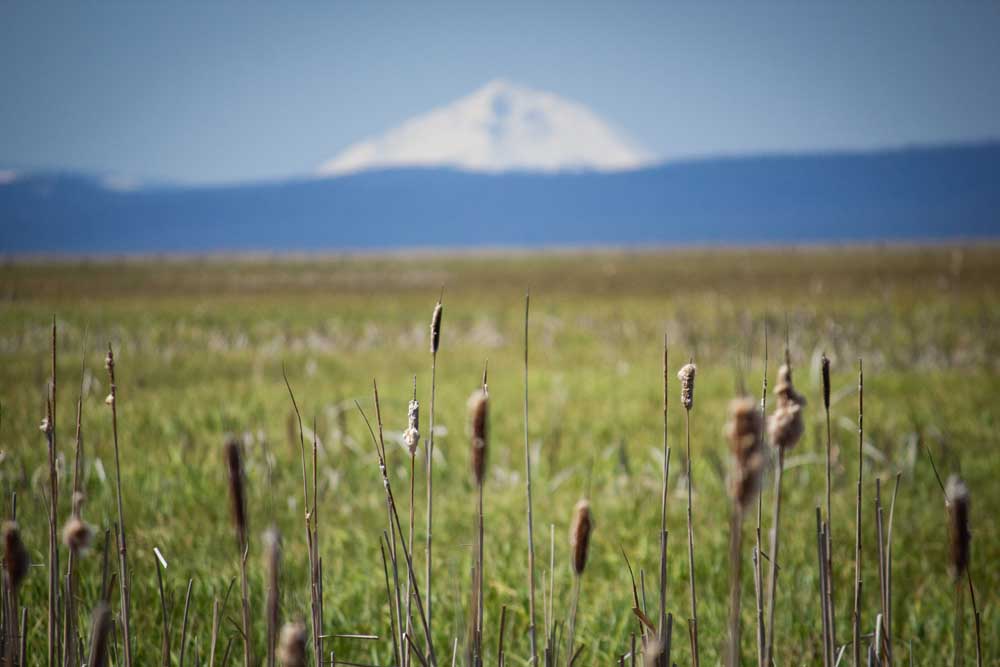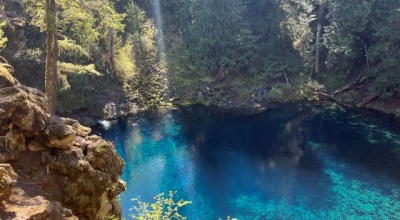Klamath Marsh National Wildlife Refuge’s scenery is for the birds
Published 6:00 am Friday, May 19, 2023

- Cattails rustle in a robust east wind in the Klamath Marsh National Wildlife Refuge, with the peak of Mount McCloughlin behind.
The wind howled over the reeds at Klamath Marsh National Wildlife Refuge last weekend as my sister, Heather, and I scanned the horizon for something other than mallards, Canada geese and the bevy of red-winged blackbirds and swallows darting across the sky in search of bugs.
The chirping of songbirds and the wind rushing on lonely, red-cindered Military Road about 35 miles northeast of Chiloquin muted the far-off calls of the migratory birds we’d been hoping to see on our now-annual birding trip.
Regardless of the bit of bummer luck — we’ve had a streak of it lately — we couldn’t help but be awed by the refuge and its stunning landscape.
After recent drought, the area has seen a great and welcome shift as our wet winter and spring have brought the marsh back to — well, a typical marsh, with deep water at Wocus Bay, and bulrushes sitting in hearty depths of that sweet, sweet H2O. And by just listening to the symphony of birdsong, I think our flighted friends are thrilled about it, too.
All creatures great and small
Klamath Marsh, 100 miles south of Bend, had long been just a name on a sign for the both of us as we adventured south through Silver Lake or, for my sister, teacher conferences in Klamath Falls. So we were eager to check out the refuge and, with hope, add to our year and life lists sightings of migratory shorebirds and waterfowl that call this place a temporary home while they nest in spring.
We may have been too late to really get a glimpse of those winged wonders like the sandhill crane, cinnamon teal, lesser scaup or even a yellow rail of which about 50% of the bird’s Western U.S. population calls the area home according to the refuge brochure, which can be picked up at the headquarters (open intermittently) and several other spots throughout the refuge.
Despite missing the larger variety that we had been hoping to see, we could hear a lot more than met the eye. A cacophony of bird songs wafted through the wind and the reeds, creating a marvelous, almost cinematic soundscape.
The refuge is home to many species, and during our trip, we saw the songbirds as mentioned above, raptors such as the American kestrel, and Rocky Mountain elk and pronghorn. It also hosts habitats for the Oregon spotted frog, great gray owls, bald eagles and many more.
If you are very lucky, you might even catch sight of the much smaller residents of the marsh including Western garter snakes out looking for a mid-day meal of small fish swimming through the deeper water among the wocus (yellow water lilies) and cattails.
With more than 43,000 acres of marshland, it’s one of the largest high-mountain marshes in the Intermountain West, according to one interpretive sign. Its wetlands, pine forests and aspen groves make it easy to see why this is such a great spot for both migrating and resident fauna.
Seeing it up close and personal
There are no hiking trails or auto-tour routes in the refuge, and entering the marsh on foot is strictly prohibited in order to protect those nesting birds and other wildlife. Plus, many forest roads are closed (always check closures before heading out) which makes finding a spot to watch the wildlife harder. Because of these facts, the drive may not seem worth the tank of gas it takes to get there and back from Bend, but there are a few ways you can view the array of wildlife and scenery here.
First, Silver Lake Road, which runs through the heart of the refuge, has a few small pull-outs where you can park for a while while peering through your binoculars hoping to see something. These are few, though, and the road noise can keep the wildlife away.
Two better options that are much quieter than the aforementioned county road: Military Road and Wocus Bay Road/Forest Service Road 7620.
The former (which has a fascinating and sordid history of its own) is a well-maintained gravel road with a perfect view of the marsh shadowed by peaks of the Cascades from Mt. McCloughlin (on a clear day) to Mt. Theilsen, with Mt. Scott taking center stage. This road travels only a short way through the marsh, and it should be noted that there is private property nearby. Be sure to be courteous to the human residents as well as the animal ones.
Wocus Bay Road is trickier. It is a poorly maintained and narrow, one-lane forest service road with deep ruts that will bottom out most sedans and give your car that Central Oregon pinstriping, thanks to overgrown sage and other underbrush. However, this leads to the deeper water areas of the marsh at Wocus Bay, and from July 1 through Sept. 30, you can paddle around in a non-motorized watercraft, getting closer to the wildlife than a car will allow.
A place in the reeds
The marsh was designated a wildlife refuge in 1958, when the U.S. Department of Fish and Wildlife used money made from duck stamps to purchase the land from the Klamath people and ranchers including Bill “Kitt” Kittredge, who had dammed the Williamson River to make pastureland for cattle in the 1910s after acquiring the ancestral lands of the Klamath people. As time went on, more acquisitions were made until the entire historic marsh was encompassed in the refuge boundaries and it grew to its current acreage.
Today, the Klamath Marsh National Wildlife Refuge is one of 18 across the state and is made up of wet meadows with open-water wetlands in the southern reaches and is maintained through various means including cattle grazing, haying and prescribed burns, according to the refuge’s website.
You can feel what’s special about this refuge as you drive out of Eastern Oregon scrubland into pine forests, then suddenly into a vast, flat array of thousands of acres of reeds and bulrushes under the eye of snow-capped Cascade peaks.
Despite the fact that we missed the migrating birds, the scenic drive through the marsh was a welcome surprise.






